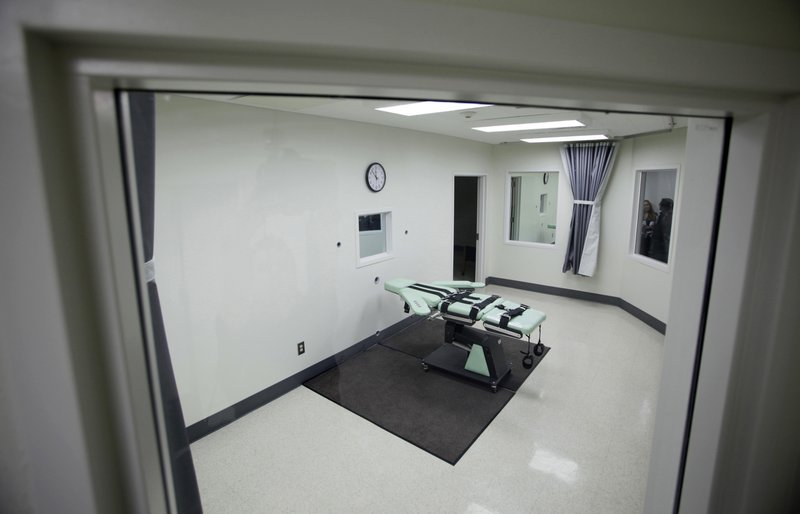SACRAMENTO, Calif. — California has long been what one expert calls a "symbolic death penalty state," one of 12 that has capital punishment on the books but has not executed anyone in more than a decade.
Prodded by voters and lawsuits, the nation's most populous state may now be easing back toward allowing executions, though observers are split on how quickly they will resume, if at all.
Corrections officials expect to meet a Wednesday deadline to submit revised lethal injection rules to state regulators, trying again with technical changes after the first attempt was rejected in December.
The California Supreme Court, meanwhile, is expected to rule by August on challenges to a ballot initiative narrowly approved by voters in November that would speed up executions by reducing the time allowed for appeals.

EXECUTIONS: In-depth look at 4 men put to death in April + 3 others whose executions were stayed
Click here for larger versions
Still, it is a far cry from the situation in Arkansas, which carried out its first execution since 2005 last week after trying to put eight inmates to death this month in an unprecedented series of double executions. Courts have blocked three of them. Legal rulings have put at least one other in doubt.
California could come close to resuming executions in the next year, said law professor Robert Weisberg, co-director of the Stanford Criminal Justice Center, though others say too many variables and challenges remain to make a prediction.
California has by far the nation's largest death row with nearly 750 inmates, about double that of No. 2 Florida.
The state's proposed lethal injection regulations are patterned after a single-drug process that already passed muster with the U.S. Supreme Court, Weisberg said.
Corrections officials submitted the regulations only after they were forced to act by a judge's ruling on behalf of crime victims angered at the state's three-year delay. But the regulations replacing California's old three-drug method are likely to be approved at some point, Weisberg said.
Deborah Denno, a professor at Fordham University School of Law and an expert on lethal injections, was among those who said recent revisions to the state's proposed regulations still don't cure underlying problems that can lead to botched executions.
For instance, the proposed rules now give executioners 10 minutes to administer each round of lethal drugs. The first batch is supposed to kill, but if that initial dose doesn't work, executioners would administer four more similar doses, each with a 10-minute countdown clock to make sure the process doesn't drag on for hours as critics said was a possibility under the original rules.
If the inmate is still alive after five massive doses, "the San Quentin Warden shall stop the execution and summon medical assistance for the inmate."
The regulations still call for letting the warden at San Quentin State Prison pick from among four powerful barbiturates — amobarbital, pentobarbital, secobarbital or thiopental — depending on which one is available as manufacturers try to limit the use of their drugs for executions. Inmates could also choose to die in the gas chamber.
The Berkeley Law Death Penalty Clinic, which opposes executions, says amobarbital and secobarbital have never been used in executions. The clinic said problems remain over how the drugs would be obtained and administered.
Officials in several other states with long-delayed executions have said their efforts to carry out the death penalty have been thwarted by a lack of lethal drugs.
Arkansas was rushing to try to execute as many inmates as possible before its supply of the controversial sedative midazolam expires at month's end. Midazolam would not be used under California's regulations.
Denno said California's regulations would still conceal the identities, training and experience of the execution team, crucial information since the deadly drugs must be properly measured, mixed and administered to ensure a painless death.
"It's a complicated process, and everything has to be going right, and it's so easy in a prison context for everything not to go right," she said. She equated it to letting amateurs provide anesthesia for surgery.
Denno and other experts said the new rules eventually will have to pass the scrutiny of U.S. District Court Judge Jeremy Fogel, who halted executions in the state in early 2006 and ordered prison officials to improve their lethal injection process.
California voters have eased penalties for many crimes in recent years but have repeatedly rejected efforts to end the death penalty. They did so again in November, when 51 percent approved Proposition 66, designed to speed up death penalty cases. Fifty-three percent of voters defeated a competing measure that would have abolished the death penalty.
The state Supreme Court quickly blocked Proposition 66 while it considers challenges.
Appellate lawyer Kirk Jenkins, who studies the court, expects the justices will reject the proposition's five-year deadline for deciding death row appeals because it violates the separation of powers. Death penalty appeals average at least a decade from the time a condemned inmate is assigned a post-trial lawyer to a final decision by the state's high court, he said, and the justices already have a backlog of about 300 capital cases.
"There is no possible way that the court could meet the deadlines in Prop. 66" without putting aside virtually all other decisions, Jenkins said.
The initiative also makes it easier for corrections officials to adopt new lethal injection procedures. But even a complete rejection of Proposition 66 would not derail the executions of inmates whose appeals are exhausted, Weisberg said. Those executions could proceed once the state has an approved lethal injection process.
Experts said the delays may give opponents time to mount another campaign next year asking voters again if they want to abolish the death penalty.
"In California, it's become a symbolic death penalty state," Denno said. "Whether that is going to change or not is unpredictable."
